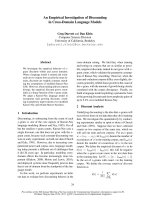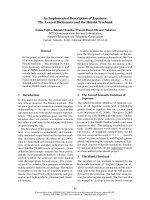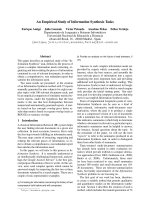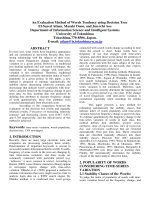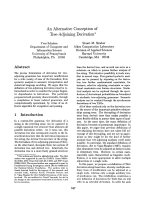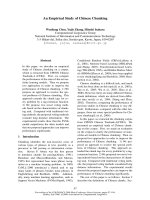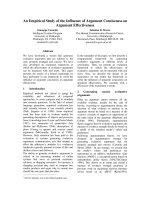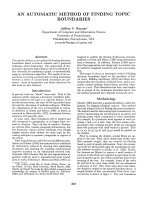Báo cáo khoa học: "AN ASSESSMENT EXTRACTED OF SEMANTIC INFORMATION FROM MACHINE READABLE AUTOMATICALLY DICTIONARIES" pptx
Bạn đang xem bản rút gọn của tài liệu. Xem và tải ngay bản đầy đủ của tài liệu tại đây (700.55 KB, 6 trang )
AN ASSESSMENT OF SEMANTIC INFORMATION AUTOMATICALLY
EXTRACTED FROM MACHINE READABLE DICTIONARIES
Jean V~ronis 1.2and Nancy Ide t
tDepartrnent of Computer Science
VASSAR COLLEGE
Poughkeepsie, New York 12601 (U.S.A.)
:~Groupe Representation et Traitement des Connalssances
CF_.~E NATIONAL DE LA RECHERCHE SCIENTIFIQUE
31, Ch. Joseph Aiguier
13402 Marseille Cedex 09 (France)
ABSTRACT
In this paper we provide a quantitative evaluation of
information automatically extracted from machine
readable dictionaries. Our results show that for any one
dictionary, 55-70% of the extracted information is
garbled in some way. However, we show that these
results can be dramatically reduced to about 6% by
combining the information extracted from five
dictionaries. It therefore appears that even if individual
dictionaries are an unreliable source of semantic
information, multiple dictionaries can play an important
role in building large lexical-semantic databases.
1. INTRODUCTION
In recent years, it has become increasingly clear that the
limited size of existing computational lexicons and the
poverty of the semantic information they contain
represents one of the primary bottlenecks in the
development of realistic natural language processing
(NLP) systems. The need for extensive lexical and
semantic databases is evident in the recent initiation of a
number of projects to construct massive generic
lexicons for NLP (project GENELEX in Europe or
EDR in Japan).
The manual coustruction of large lexical-semantic
databases demands enormous human resources, and
there is a growing body of research into the possibility
of automatically extracting at least a part of the required
lexical and semantic informati'on from everyday
dictionaries. Everyday dictionaries are obviously not
structured in a way that enables their immediate use in
NLP systems, but several Studies have shown that
relatively simple procedures can be used to extract
taxonomies and various other semantic relations (for
example, Amsler, 1980; Calzolari, 1984; Cbodorow,
Byrd, and Heidorn, 1985; Markowitz, Ahlswede, and
Evens, 1986; Byrd et al., 1987; Nakamura and Nagao,
1988; Vtronis and Ide, 1990~ Klavans, Chodorow, and
Wacholder, 1990; Wilks et al., 1990).
However, it remains to be seen whether information
automatically extracted from dictionaries is sufficiently
complete and coherent to be actually usable in NLP
systems. Although there is concern over the quality of
automatically extracted lexical information, very few
empirical studies have attempted to assess it
systematically, and those that have done so have been
restricted to consideration of the quality of grammatical
information (e.g., Akkerman, Masereeuw, and Meijs,
1985). No evaluation of automatically extracted
semantic information has been published.
The authors would like to thank Lisa Lassck and Anne Gilman
for
their
contribution to this work.
In this paper, we report the results of a quantitative
evaluation of automatically extracted sernanuc data. Our
results show that for any one dictionary, 55-70% of the
extracted information is garbled in some way. These
results at first call into doubt the validity of automatic
extraction from dictionaries. However, in section 4 we
show that these results can be dramatically reduced to
about 6% by several means most significantly, by
combining the information extracted from five
dictionaries. It therefore appears that even if individual
dictionaries are an unreliable source of semantic
information, multiple dictionaries can play an important
role in building large lexical-semantic databases.
2. METHODOLOGY
Our strategy involves automatically extracting
hypernyms from five English dictionaries for a limited
corpus. To determine where problems exist, the
resulting hierarchies for each dictionary are compared to
an "ideal" hierarchy constructed by hand. The five
dictionaries compared were: the Collins English
Dictionary (CED), the Oxford Advanced Learner's
Dictionary (OALD), the COBUILD Dictionary, the
Longman's Dictionary of Contemporary English
(LDOCE) and the Webster's 9th Dictionary (W9).
We begin with the most straightforward case in order to
determine an upper bound for the results. We deal with
words within a domain which poses few modelling
problems, and we focus on hyperonymy, which is
probably the least arguable semantic relation and has
been shown to be the easiest to extract. If the results are
poor under such favorable constraints, we can foresee
that they will be poorer for more complex (abstract)
domains and less clearly cut relations.
An ideal hicrarchy probably does not exist for the entire
dictionary; however, a fair degree of consensus seems
possible for carefully chosen terms within a very
restricted domain. We have therefore selected a corpus
of one hundred kitchen utensil terms, each representing
a concrete, individual object for example,
cup, fork,
saucepan, decanter,
etc. All of the terms are count
nouns. Mass nouns, which can cause problems, have
been excluded (for example, the mass noun
cutlery
is
not a hypernym of
knife).
Other idiosyncratic cases,
such as
chopsticks
(where it is not clear if the utensil is
one object or a pair of objects) have also been
eliminated from the corpus. This makes it easy to apply
simple tests for hyperonymy, which, for instance,
enable us to say that Y is a hypcmym of X if "this is an
X"
entails but is not entailed by "this is
a Y"
(Lyons,
1963).
Chodorow, Byrd, and Heidorn (1985) proposed a
heuristic for extracting hypernyms which exploits the
fact that definitions for nouns typically give a hypemym
- 227 -
term as the head of the defining noun phrase. Consider
the following examples:
dipper a ladle used for dipping ICEDi
ladle a long-handled spoon ICED]
spoon
a metal, wooden, or plastic utensil ICED]
In very general terms, the heuristic consists of
extracting the word which precedes the first
preposition, relative pronoun, or participle encountered
in the definition text. When this word Is "empty" (e.g.
one, any, kind, class) the true hyperuym is the head of
the noun phrase following the preposition of'.
slice any of various utensils [CEDI
Automatically extracted hierarchies are necessarily
tangled (Amsler, 1980) because many words are
polysemous. For example, in the CED, the word pan
has the following senses (among others):
pan ! l.a a wide metal vessel ICEDI
pan 2
1 the leaf of the betel tree , iCED]
The CED also gives pan as the hypemym for saucepan,
which taken together yields the hierarchy in figure l.a.
The tangled hierarchy is problematic because, following
the path upwards from saucepan, we find that saucepan
can be a kind of leaf. This is clearly erroneous. A
hierarchy utilizing senses rather than words would not
be tangled, as shown in figure 1.b.
In our study, the hierarchy waS disambiguated by hand.
Sense disambiguation in dictionary definitions is a
difficult problem, and we will not address it here; this
problem is the focus of much current research and is
considered in depth elsewhere (e.g., Byrd et al., 1987;
Byrd, 1989; Vtronis and Ide, 1990; Klavans,
Chodorow, and Wacholder, 1990; Wilks et al., 1990).
vessel leaf vessel I leaf l
I I
saucepan saucepan I
a) v,,ord hitrarchy b) sense hierarchy
Figure I : Sense-tangled"
hierarchy
3. EVALUATION
Hierarchies constructed with methods such as those
outlined in section 2 show, upon close inspection,
several serious problems. In this section, we describe
thc most pervasive problems and give their frequency in
our five dictionaries. The problems fall into two general
types: those which arise because information in the
dictionary is incomplete, and those which are the result
of a lack of distinction among terms and the lack of a
one-to-one mapping between terms and concepts,
especially at the highest levels of the hierarchy.
3.1. Incomplete information
The information in dictionaries is incomplete for
two
main reasons. First, since a dictionary is typically the
product of several lexicographers' efforts and is
constructed, revised, and updated over many years,
there exist inconsistencies in the criteria by which the
hypernyms given in definition texts are chosen. In
addition, space and readability restrictions, on the one
hand, and syntactic restrictions on phrasing, on the
other, may dictate that certain information is unspecified
in definition texts or left to be implied by other parts of
the definition.
3.1.1. Attachment too high : 21-34%
The most pervasive problem in automatically extracted
hierarchies is the attachment of terms too high in the
hierarchy. It occurs in 21-349'0 of the definitions in our
sample from the five dictionaries (figure 8). For
example, while pan and bottle are vessels in the CED,
cup and bowl are simply containers, the hypemym of
vessel. Obviously, "this is a cup" and "this is a bowl"
both entail (and are not entailed by) "this is a vessel".
Further, other dictionaries give vessel as the hypemym
for cup and bowl. Therefore, the attachment of cup and
bowl to the higher-level term container seems to be an
inconsistency within the CED.
The problem of attachment too high in the hierarchy
occurs relatively randomly within a given dictionary. In
dictionaries with a controlled definition vocabulary
(such as the LDOCE), the problem of attachment at
high levels of thehierarchy results also from a lack of
terms from which to choose. For example, ladle and
dipper are both attached to spoon in the LDOCE,
although "this is a dipper" entails and is not entailed by
"this is a ladle". There is no way that dipper could be
defined as a ladle (as, for instance, in the CED), since
ladle is not in the defining vocabulary. As a result,
hierarchies extracted from the LDOCE are consistently
flat (figure 7).
3.1.2. Absent hypernyms : 0-3%
In some cases, strategies likc that of Chodorow, Byrd
and Hcidorn yield incorrect hypernyms, as in the
following definitions:
g r ill A grill is a part of a cooker [COBUILD]
corkscrew a pointed spiral piece of metal [W9I
dinner service a ecm~plete set of plates and dishes [LDOCE,
not included in
our
corpus]
The words part, piece, set, are clearly not hypernyms
of the defined concepts: it is virtually meaningless to
say that grill is a kind of part, or that corkscrew is a
kind of piece. In these cases, the head of the noun
phrase serves to mark another relation: part-whole,
member-class, etc. It is easy to reject these and similar
words (member, :series, etc.) as hypemyms, since they
form a closed list (Kiavans, Chodorow, and
Wacholder, 1990). However, excluding these words
leaves us with no hypernym. We call these "absent
hypernyms"; they occur in 0-3% of the definitions in
our sample corpus (figure 8).
The absence of a hypernym in a given definition text
does not necessarily imply that no hypernym exists.
For example, "this is a corkscrew" clearly entails (and
is not entailed by) "this is a device" (the hypemym
given by the COBUILD and the CED). In many eases,
the lack of a hypernym seems to be the result of
concern over space and/or readability. We can imagine,
for example, that the definition for corkscrew could be
more fully specified as "a device consisting of a pointed
spiral piece of metal " In such cases, lexicographers
rely on the reader's ability to deduce that something
made of metal, with a handle, used for pulling corks,
can be called a device. However, for some terms, such
as cutlery or dinner service, it is not clear that a
hypernym exists. Note that we have voluntarily
excluded problematic terms of this kind from our
corpus, in order to restrict our evaluation to the best
Case.
3.1.3. Missing overlaps : 8-14%
Another problem results from the necessary choices that
lexicographers must make in an attempt to specify a
- 228 -
single superordinate, when concepts in the real world
overlap freely. For instance, a saucepan can be said to
be a pot as well as a pan. "This is a saucepan" entails
both "this is a pot" (the hypernym given by the CED
and W9) as well as "this is a pan" (the hypernym given
by the LDOCE, OALD, and COBUILD). On the other
hand, "this is a pot" does not entail and is not entailed
by "this is a pan", which is to say thatpot andpan are
not synonyms, nor is one the hypernym of the other. In
terms of classes, pan and pot are distinct but
overlapping, and saucepan is a subset of their
intersection (figure 2.a). This is no longer a strict
hierarchy since it includes merging branches (figure
2.b). We will call it an "overlapping hierarchy".
Although a tree representation of such a hierarchy is
impossible, it presents no problems on either logical or
computational grounds.
b)
saucepan
Figure 2. Overlapping hierarchy
Assuming the above relations, it would be more
logically correct to phrase the definition of saucepan as
"a pan AND a pot ". However, lexicographers never
use "and" in this way, but usually give only one of the
alternatives. For example, each of the five dictionaries
in our study chooses eitherpot orpan as the genus term
for saucepan. When this occurs, one of the hypemyms
is missing. This problem arises in our sample corpus
relatively frequently, 8-14% of the time depending on
the dictionary (figure 8).
3.2. Difficulties at higher levels
At the higher levels of the hierarchy, terms necessarily
become more general, and they often become less
clearly defined. For example, most people wilt agree on
whether some object falls imo the category fork or
spoon, but there is much less agreement on what
objects are implements or utensils. In addition, at the
higher levels some concepts simply lack a term to
designate them exactly. As a result~ there is confusion
at the higher levels of hierarchies implicit in dictionary
definitions.
3.2.1. OR-conjoined heads : 7-10%
For 7-10% of the terms in our corpus, definitions give
a list of head nouns separated by the conjunction or, as
in the following:
utensil an
implement, tool
or
container
[CEDI
In this case, none of the three alternatives is a
hypemym of utensil. First, it is clearly not true that
"this is a utensil" entails "this is a container". For the
other two, it is not clear whether or not "this is a
utensil" entails "this is a tool" and "this is an
implement", and it is even less clear that the reverse
entailments do not apply. Regarding the three terms as
hypernyms of utensil would produce the hierarchy in
figure 3. However, by enumerating the paths upwards
from spatula (defined as a utensil), we see that spatula
is a kind of container, which is obviously incorrect.
This solution amounts to regarding the class of utensils
as the intersection of the classes of implements, tools,
and containers. Regarding the conjunction or as
denoting the union of these classes would be more
correct on logical grounds, since if X is included in A
or X is included in B, then X is included in A u B.
This relation cannot be fitted into a tree, but it can be
pictured as in figure 4. However, this does not help to
determine whether spatula is an implement, tool, or
container, or some subset of the three. In any case,
lexicographers do not use or with a consistent,
mathematical meaning. Or-conjoined heads appear not
to be usable in constructing hierarchical trees without
considerable manipulation and addition of information.
implement
tool container
W~ONG/
spatula
Figure 3 : problematic hierarchy
Figure 4. OR as class union
3.2.2. Circularity :
7-11%
It is well known that circularity exists in dictionary
definitions, especially when concepts are high up in the
hierarchy. For instance, consider the definitions below:
tool
an implement,
such
as
a hammer ICED]
Implement a piece of
equipment; tool
or
utensil.
ICED]
ute nsl I ar~
implement, tool or container
[CED]
Circular definitions yield hierarchies containing loops
(figure 5.a). Unlike merging branches, loops have no
interpretation in terms of classes. A loop asserts both
that A is a sub-class of B and B is a sub-class of A,
which yields A := B. This is why Amsler (1980)
suggests merging circularly-defined concepts and
regarding them as synonyms (figure 5.b).
container
Implement ~~ut!/nunnu~ tool container
a)
spatula
b)
spatula
Figure 5. Taxonomy with loops
However, in most cases this solution leads to erroneous
results; it is clear, for example, that many implements,
tools, and utensils (e.g., spatula) are not containers.
This problem is similar to the one cited above in section
3.2.1. If dictionary definitions are to be interpreted in
terms of set theoretical relations, a more complex
mathematical treatment is required. The definitions
above can be represented by the following relations:
tool ~ implement
Implement c (equipment u tool u utensil)
utensil c (Implement u tool u container)
which, once solved, do not equate tool, implement,
and utensil, but instead define the overlapping classes
in figure 6. This representation is clearly more sound
on logical grounds. It still does not indicate exactly
- 229 -
whcrc spatula should appear (since wc have no
indication that it is not a conlainer), but at least it shows
that there may be some utensils which arc
not
containers.
Although this representation is more intuitively accurate
than the representation in figure 5.b, ultimately it goes
• too far in delineating the relations among terms. In
actual use, the distinctions among terms are much less
clear-cut than figure 6 implies, For instance, the figure
indicates that all tools that are containers are also
implements, but it is certainly not clear that humans
would agree to this or use the terms in a manner
consistent with this specification. Dictionaries
themselves do not agree, and when taken formally they
yield very different diagrams for higher level concepts.
object container "
gl!ss bow~e~l
plate tureen pressure, coffee- bottle pan
cooker pot
frying-pan saucepan
container
Figure 6. Solving "loops"
Figure 8 shows that 7-11% of the definitions use a
hypcmym that is itself defined circularly.
utensil instrument implement
spatula spoon knife fork
I
ladle
dippe¢
glass bowl cup dish kettle pot coffee- teapot bottle pan
pre~sure-
cooker r, aucepan frying-pan dipper
Figure 7. Hierarchies for the CED and LDOCE
plate tureen
%
tool Made instrument
AI I
spatula spoon knife fork
COB UILD
3.3.
Summary
Altogether, the problems described in the sections
above yield a 55-70% error rate in automatically
extracted hierarchies. Given that we have attempted to
consider the most favorable case, it appears that any
single dictionary, taken in isolation, is a poor source of
automatically extracted semanlic information. This is
made more cvidcm in figure 7, which demonstrates the
marked differences in hierarchies extracted from the
CED and LDOCE for a small subset of our corpus. A
summary of our results appears in figure 8.
COLliNS I.DOCE OALD W9
COMBINED
Figure 8. (~uantitative evaluation
4. REFINING
We have concluded that hierarchies extracted using
strategies such as that of Chodorow, Byrd, and
Heidom are seriously flawed, and are therefore likely to
be unusable in NLP systems. However, in this section
we discuss various means to refine automatically
extracted hierarchies, most of which can be pcrformcd
automatically.
230 -
WORD COIIUILD COLLINS LDocE 'OALD W9
ladle spoon spoon spoon
h a s
i
n container container container
ewer jug jug OR pitcher container
saucepan pot pan pot
grill
(absent) devioe (absent)
fork tool . implement instrument
Figure 9. Mer
4.1. Merging dictionaries
It is possible to use information provided in the
differentiae of definition texts to refine hierarchies; for
example, in the definition
vessel any
object
USI.:D AS a
container
ICED]
the automatically extracted hypernym is object.
However, some additional processing of the definition
text enables the extraction of container following the
phrase "used as". It is also possible to use other
definitions. For example, the CED does not specify that
knife and spoon are implements, but this information is
provided in the definition of cutlery:
cutlery implements used for eating SUCII AS
knives,
forks,
and
spoons.
ICED]
The extraction of information from differentiae
demands some extra parsing, which may be difficult for
complex definitions. Also, further research is required
to determine which phrases function as markers for
which kind of information, and to determine how
consistent their use is. More importantly, such
information is sporadic, and its extraction may require
more effort than the results warrant. We therefore seek
more "brute force" methods to improve automatically
ex tracted hierarchies.
One of the most promising strategies for refining
extracted information is the Use of information from
several dictionaries. Hierarchies derived from
individual dictionaries suffer from incompleteness, but
it is extremely unlikely that the same information is
consistently missing from all dictionaries. For instance,
the CED attaches cup to container, which is too high in
the hierarchy, while the W9 attaches it lower, to vessel.
It is therefore possible to use taxonomic information
from several dictionaries to fill in absent hypemyms,
missing links, and to rectify cases of too high
attachment.
To investigate this possibility, we merged the
information extracted from the five English dictionaries
in our database. The individual data for the five
dictionaries was organized in a table, as in figure 9.
Merging these hierarchies into a single hierarchy was
accomplished automatically by applying a simple
algorithm, which scans the table line-by-line, as
follows:
1) regard cells containing multiple heads conjoined
by or as null, since, as we saw in section 3.2.1, they
do not reliably provide a hypemym.
2) if all the cells agree (as for ladle), keep that term as
the hypernym. Otherwise:
a) if a term is a hypernym of another term in the
line, ignore it.
b) take the remaining cell or cells as the
hypernym(s).
This algorithm must be applied recursively, since, for
example, it may not yet be known when evaluating
bct~in that container is a hypernym of vessel, and vessel
is a hypemym of bowl, until those terms are themselves
•
Combined
spoon spoon spoon
bowl vessel bowl
pitcher pitcher OR jug ; pitcher
pot ,, pan pot AND pan
device utensil device AND utensil
implement implement tool, implement AND instrument
ing hierarchies
processed. Therefore, several passes through the tab!e
are required. Note that if after applying the algorithm
several terms are left as hypernyms for a given word,
we effectively create an overlap in the hierarchy. For
example, saucepen is attached to both pot and pan, and
fork is attached to tool, implement, and instrument.
We evaluate the quality of the resulting combined
hierarchy using the same strategy applied in section 3.
It is interesting to note that in the merged hierarchy, all
the absent hypernym problems (including absence due
to or-heads) have been eliminated, since in every case at
least one of the five dictionaries gives a valid
hypemym. In addition, almost all of the attachments too
high in the hierarchy and missing overlaps have
disappeared, although a few cases remain (5% and 1%,
respectively). None of the dictionaries, for instance,
gives pot as the hypemym of teapot, although three of
the five dictionaries give pot as the hypernym of
coffeepot. A larger dictionary database would enable
the elimination of many of these remaining
imperfections (for example, New Penguin English
Dictionary, not included in our database, gives pot as a
hypemym of teapot).
Merging dictionaries on a large scale assumes that it is
possible to automatically map senses across them. For
our small sample, we mapped senses among
dictionaries by hand. We describe elsewhere a
promising method to automatically accomplish sense
mapping, using a spreading activation algorithm (lde
and Vtronis, 1990).
4.2. Covert categories
There remain a number of circularly-defined hypemyms
in the combined taxonomy, which demand additional
consideration on theoretical grounds. Circularly-def'med
terms tend to appear when lexicographers lack terms to
designate certain concepts. The fact that "it is not
impossible for what is intuitively recognized as a
conceptual category to be without a label" has already
been noted (Cruse, 1986, p. 147). The lack of a
specific term for a recognizable concept tends to occur
more frequently at the higher levels of the hierarchy
(and at the very lowest and most specific levels as
well e.g., there is no term to designate forks with two
prongs). This is probably because any language
includes the most terms at the generic level (Brown,
1958), that is, the level of everyday, ordinary terms for
objects and living things (dog, pencil, house, etc.).
Circularity, as well as the use of or-conjoined terms at
the high levels of the hierarchy, results largely from the
lexicographers' efforts to approximate the terms they
lack. For example, there is no clear term to denote that
category of objects which fall under any of the terms
utensil, tool, implement, instrument, although this
concept seems to exist. Clearly, these terms are not
strictly synonymous there are, for example, utensils
that one would not call tools (e.g., a colander). If a
term, let us say X, for the concept existed, then the
definitions for utensil, tool, implement, and instrument
- 231 -
could simply read "an X that ". Since this is not the
case, lexicographers define each term with a list
including the others, which enables the delineation of a
concept which encompasses all of them.
One way to resolve difficultieslat the higher levels of
extracted hierarchies is to introduce "covert categories",
that is, concepts which do not correspond to any
particular word. We therefore do not merge circular
terms into a single concept, but instead create
a
common "covert" hypcrnym for all of them. In this
way, tool, utensil, implement; and instrument each
appear in the hierarchy as kinds: of INSTRUMENTAL-
OBJECT (covert categories names are capitalized).
We need a means to determine when and where covert
categories are necessary. Circularities in dictionary
definitions clearly indicate the presence of covert
categories. However, we obviously cannot use a single
dictionary to determine them, because the loops
contained in one dictionary rarely include all of the
terms that may bc involved in the "constellation"
representing a given covert category. For instance, the
CED contains the loop tool-implement-utensil, while
the COBUILD contains a loop for tool-instrument; this
provides strong evidence that all four terms should be
involved in a constellation. Supporting information can
be derived by looking at the hyponyms for each of the
candidate terms in different dictionaries. The word
fork, for example, is defined as tool (COBUILD),
implement (CED, OALD, W9), and instrument
(LDOCE), while spoon is defined as object
(COBUILD), utensil (CED, OALD), tool (LDOCE)
and implement (W9),which adds further support to the
idea that tool, utensil, instrument, and implement
belong to tile same constellation.
Even if it is relatively easy to automatically detect
circularities, the final determination of which covert
categories to create and the terms that are involved in
them must be done manually. However, this task is not
as daunting as it may first appear, since it involves only
the higher levels of the hierarchy, and likely involves a
relatively small number of covert categories.
4.3. Summary
By merging five dictionar!es, all but 6% of the
problems found in individual dictionaries were
eliminated (figure 8). This result is made clear in figure
10, which includes the same small subset of the sample
corpus as in rite individual hierarchies given in figure 7.
Although there remain a few imperfections, the
combined hierarchy is much more accurate and
complete, and therefore more useful, than the hierarchy
derived from any one of the d~tionaries alone.
5. CONCLUSION
The results of our study show that dictionaries can be a
reliable source of automatically extracted semantic
information. Merging information from several
dictionaries improved the quality of extracted
information to an acceptable level. However, these
results were obtained for a selected corpus representing
a best case situation. It is likely that different results
will be obtained for larger, less restricted cases. Our
results suggest that this is an encouraging line of
research to pursuefor refining automatically extracted
information.
REFERENCES
AKKERMAN, E., MASEREEUW, P. C., MEIJS. W. J. (1985).
Designing a computerized lexicon for linguistic purposes.
ASCOT Report No. 1,
Rodopi, Amsterdam.
AMSLER, R. A. (1980).
The structure of the Merriam.Webster
Pocket Dictionary~
Ph.D. Diss., U. Texas at Austin.
BROWN, R. W. 0958) llow shall a thing be called?
Psychological Review,
65, 14-21.
BYRD, R. J. (1989) Discovering relationships among word
senses.
Prec. 5th Conf. OW Centre for the New OED,
Oxford.
67-79.
BYRD, R. J., CALZOLAR1, N., CIIODOROW, M. S., KLAVANS,
J. L., NEFF, M. S RIZK, O. (1987) Tools and methods for
Computational linguistics.
Computational Linguistics,
13.
3/4, 219-240.
CALZOLARI, N.(1984). Detecting patterns in a lexical data base.
COLING'84,
170=173.
CIIODOROW, M. S., BYRD. R. J., IIEIDORN. G. E. (1985).
Extracting semantic hierarchies from a large on-line dictionary.
Prec. 23rd Annual Conf. of the ACL,
Chicago, 299-304.
CRUSE, D. A. (1986).
Lexical semantics,
Cambridge University
Press, Cambridge.
IDE, N M., VI~RONIS, J. (1990). Mapping Dictionaries: A
Spreading Activation Approach,
Prec. 6th Conf. UW Centre
for the blew OED,
Waterloo, 52-64.
KLAVANS, J., CIIODOROW, M., WACIIOLDER, N 0990). From
dictionary to knowledge base via taxonomy.
Prec. 6th Conf.
.UW Centre for the New OED,
Watedoo, t I0-132.
LYONS, J. (i 963)
Structural semantics.
Blackwell, Oxford.
MARKOWITZ, J., AIILSWEDE, T., EVENS, M. (1986).
Semantically significant patterns in dictionary definitions.
Prec. 24rd Annual Conf. of the ACL,
New York, ! 12-119.
NAKAMURA, J., NAGAO, M. (1988). Extraction of semantic
'information from an ordinary English dictionary and its
:evaluation.
COLING'88,
459-464.
VI~RONIS, J., IDE, N., M. (1990). Word Sense Disambiguation
with Very Large Neural Networks Extracted from Machine
Readable Dictionaries,
COLING~90,
llelsinki.
WILKS, Y., D. FASS, C. GUO, J. MACDONALD, T. PLATE, B.
SLATOR (1990). Providing Machine Tractable Dictionary
Tools.
Machine Translation,5,
99-154.
container
I
vessel
glass bottle kettle teapot pot dish
coffeep~~ plate/~
saucepan frying- cup tureen
pressure-cooker
Figure 10. Five
I
ladle
I
dipper
dictionaires
combined
- 232 -

